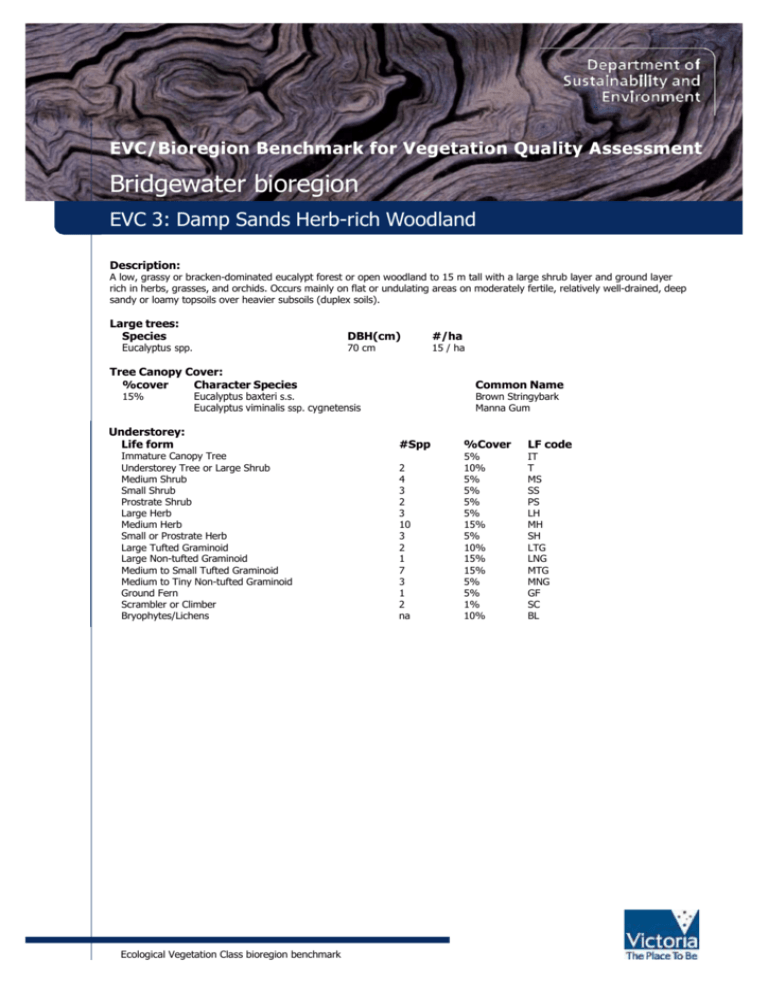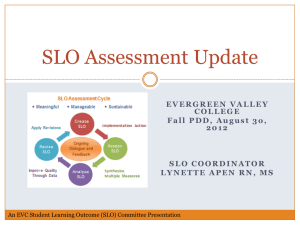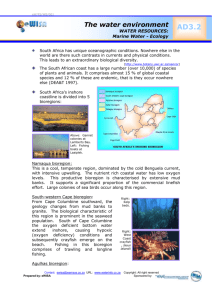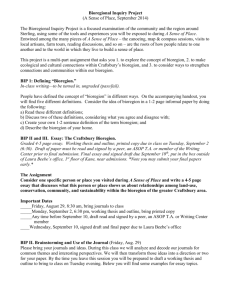Bridgewater bioregion
advertisement

EVC/Bioregion Benchmark for Vegetation Quality Assessment Bridgewater bioregion EVC 3: Damp Sands Herb-rich Woodland Description: A low, grassy or bracken-dominated eucalypt forest or open woodland to 15 m tall with a large shrub layer and ground layer rich in herbs, grasses, and orchids. Occurs mainly on flat or undulating areas on moderately fertile, relatively well-drained, deep sandy or loamy topsoils over heavier subsoils (duplex soils). Large trees: Species DBH(cm) Eucalyptus spp. 70 cm Tree Canopy Cover: %cover Character Species 15% Immature Canopy Tree Understorey Tree or Large Shrub Medium Shrub Small Shrub Prostrate Shrub Large Herb Medium Herb Small or Prostrate Herb Large Tufted Graminoid Large Non-tufted Graminoid Medium to Small Tufted Graminoid Medium to Tiny Non-tufted Graminoid Ground Fern Scrambler or Climber Bryophytes/Lichens Ecological Vegetation Class bioregion benchmark 15 / ha Common Name Eucalyptus baxteri s.s. Eucalyptus viminalis ssp. cygnetensis Understorey: Life form #/ha Brown Stringybark Manna Gum #Spp %Cover LF code 2 4 3 2 3 10 3 2 1 7 3 1 2 na 5% 10% 5% 5% 5% 5% 15% 5% 10% 15% 15% 5% 5% 1% 10% IT T MS SS PS LH MH SH LTG LNG MTG MNG GF SC BL EVC 3: Damp Sands Herb-rich Woodland - Bridgewater bioregion LF Code Species typical of at least part of EVC range Acacia melanoxylon Acacia mearnsii Banksia marginata Leucopogon parviflorus Spyridium parvifolium Leucopogon lanceolatus var. lanceolatus Hibbertia sericea s.l. Amperea xiphoclada var. xiphoclada Pimelea humilis Astroloma humifusum Acrotriche serrulata Senecio tenuiflorus Senecio glomeratus Veronica calycina Lagenophora stipitata Brunonia australis Hydrocotyle laxiflora Dichondra repens Opercularia varia Kennedia prostrata Xanthorrhoea minor ssp. lutea Deyeuxia quadriseta Dianella revoluta s.s. Luzula meridionalis Dichelachne crinita Lomandra nana Microlaena stipoides var. stipoides Ficinia nodosa Centrolepis strigosa ssp. strigosa Pteridium esculentum Billardiera scandens Galium australe T T MS MS MS MS SS SS SS PS PS LH LH MH MH MH SH SH SH SH LTG LTG MTG MTG MTG MTG MNG MNG TTG GF SC SC Common Name Blackwood Black Wattle Silver Banksia Coast Beard-heath Dusty Miller Lance Beard-heath Silky Guinea-flower Broom Spurge Common Rice-flower Cranberry Heath Honey-pots Slender Fireweed Annual Fireweed Hairy Speedwell Common Bottle-daisy Blue Pincushion Stinking Pennywort Kidney-weed Variable Stinkweed Running Postman Small Grass-tree Reed Bent-grass Black-anther Flax-lily Common Woodrush Long-hair Plume-grass Dwarf Mat-rush Weeping Grass Knobby Club-sedge Hairy Centrolepis Austral Bracken Common Apple-berry Tangled Bedstraw Recruitment: Continuous Organic Litter: 40 % cover Logs: 15 m/0.1 ha. Weediness: LF Code MH MH LNG MNG Typical Weed Species Hypochoeris radicata Centaurium erythraea Holcus lanatus Aira elegantissima Common Name Invasive Impact Cat's Ear Common Centaury Yorkshire Fog Delicate Hair-grass high high high high low low high low Published by the Victorian Government Department of Sustainability and Environment May 2004 © The State of Victoria Department of Sustainability and Environment 2004 This publication is copyright. Reproduction and the making available of this material for personal, in-house or non-commercial purposes is authorised, on condition that: • the copyright owner is acknowledged; • no official connection is claimed; • the material is made available without charge or at cost; and • the material is not subject to inaccurate, misleading or derogatory treatment. Requests for permission to reproduce or communicate this material in any way not permitted by this licence (or by the fair dealing provisions of the Copyright Act 1968) should be directed to the Nominated Officer, Copyright, 8 Nicholson Street, East Melbourne, Victoria, 3002. For more information contact: Customer Service Centre, 136 186 This publication may be of assistance to you but the State of Victoria and its employees do not guarantee that the publication is without flaw of any kind or is wholly appropriate for your particular purposes and therefore disclaims all liability for any error, loss or other consequence which may arise from you relying on any information in this publication. www.dse.vic.gov.au EVC/Bioregion Benchmark for Vegetation Quality Assessment Bridgewater bioregion EVC 9: Coastal Saltmarsh Description: Occurs on and immediately above marine and estuarine tidal flats and contains distinct floristic communities as bands or zones in the same location, depending on the positioning of the various floristic communities in relation to the saline environment. Consists of a range of life forms including succulent herbs, low succulent shrubs, rushes and sedges. Life Forms: Life form Medium Shrub Small Shrub Medium Herb Large Non-tufted Graminoid Medium to Tiny Non-tufted Graminoid Soil Crust #Spp 1 1 3 1 1 na Total understorey projective foliage cover LF Code MS SS MH MH MH LNG MNG MNG Species typical of at least part of EVC range Sclerostegia arbuscula Suaeda australis Sarcocornia quinqueflora Samolus repens Hemichroa pentandra Juncus kraussii ssp. australiensis Triglochin striatum Distichlis distichophylla Recruitment: Continuous Organic Litter: 10% cover Weediness: There are no consistent weeds in this EVC. Ecological Vegetation Class bioregion benchmark %Cover 10% 5% 15% 5% 5% 10% LF code MS SS MH LNG MNG S/C 45% Common Name Shrubby Glasswort Austral Seablite Beaded Glasswort Creeping Brookweed Trailing Hemichroa Sea Rush Streaked Arrowgrass Australian Salt-grass EVC 9: Coastal Saltmarsh - Bridgewater bioregion Published by the Victorian Government Department of Sustainability and Environment December 2004 © The State of Victoria Department of Sustainability and Environment 2004 This publication is copyright. Reproduction and the making available of this material for personal, in-house or non-commercial purposes is authorised, on condition that: • the copyright owner is acknowledged; • no official connection is claimed; • the material is made available without charge or at cost; and • the material is not subject to inaccurate, misleading or derogatory treatment. Requests for permission to reproduce or communicate this material in any way not permitted by this licence (or by the fair dealing provisions of the Copyright Act 1968) should be directed to the Nominated Officer, Copyright, 8 Nicholson Street, East Melbourne, Victoria, 3002. For more information contact: Customer Service Centre, 136 186 This publication may be of assistance to you but the State of Victoria and its employees do not guarantee that the publication is without flaw of any kind or is wholly appropriate for your particular purposes and therefore disclaims all liability for any error, loss or other consequence which may arise from you relying on any information in this publication. www.dse.vic.gov.au EVC/Bioregion Benchmark for Vegetation Quality Assessment Bridgewater bioregion EVC 10: Estuarine Wetland Description: Grows on anaerobic peat-rich muds on the edges of estuarine waterbodies such as creeks, rivers and lagoons with intermediate salinity conditions. Vegetation is determined by fluctuating salinity, which varies in time from occasionally fresh to brackish or occasionally saline according to river flood and marine tide events. Dominated by graminoids and halophytic herbs. Life Forms: Life form Medium Herb Small or Prostrate Herb Large Tufted Graminoid Large Non-tufted Graminoid Medium to Tiny Non-tufted Graminoid LF Code #Spp 2 1 1 1 3 Species typical of at least part of EVC range Samolus repens Sarcocornia quinqueflora ssp. quinqueflora Sarcocornia quinqueflora Gahnia filum Juncus kraussii ssp. australiensis Poa poiformis Distichlis distichophylla Schoenoplectus pungens Apodasmia brownii Baumea juncea Calystegia sepium MH MH MH LTG LNG MTG MNG MNG MNG MNG SC Recruitment: Episodic/Flood: desirable period of disturbance is every five years Organic Litter: 10% cover Weediness: There are no consistent weeds in this EVC. Ecological Vegetation Class bioregion benchmark %Cover 50% 10% 10% 5% 30% LF code MH SH LTG LNG MNG Common Name Creeping Brookweed Beaded Glasswort Beaded Glasswort Chaffy Saw-sedge Sea Rush Coast Tussock-grass Australian Salt-grass Sharp Club-sedge Coarse Twine-rush Bare Twig-sedge Large Bindweed EVC 10: Estuarine Wetland - Bridgewater bioregion Published by the Victorian Government Department of Sustainability and Environment December 2004 © The State of Victoria Department of Sustainability and Environment 2004 This publication is copyright. Reproduction and the making available of this material for personal, in-house or non-commercial purposes is authorised, on condition that: • the copyright owner is acknowledged; • no official connection is claimed; • the material is made available without charge or at cost; and • the material is not subject to inaccurate, misleading or derogatory treatment. Requests for permission to reproduce or communicate this material in any way not permitted by this licence (or by the fair dealing provisions of the Copyright Act 1968) should be directed to the Nominated Officer, Copyright, 8 Nicholson Street, East Melbourne, Victoria, 3002. For more information contact: Customer Service Centre, 136 186 This publication may be of assistance to you but the State of Victoria and its employees do not guarantee that the publication is without flaw of any kind or is wholly appropriate for your particular purposes and therefore disclaims all liability for any error, loss or other consequence which may arise from you relying on any information in this publication. www.dse.vic.gov.au EVC/Bioregion Benchmark for Vegetation Quality Assessment Bridgewater bioregion EVC 23: Herb-rich Foothill Forest Description: Occurs on relatively fertile, moderately well-drained soils on an extremely wide range of geological types and in areas of moderate to high rainfall. Occupies easterly and southerly aspects mainly on lower slopes and in gullies. A medium to tall open forest or woodland to 25 m tall with a small tree layer over a sparse to dense shrub layer. A high cover and diversity of herbs and grasses in the ground layer characterise this EVC. Large trees: Species DBH(cm) Eucalyptus spp. 70 cm Tree Canopy Cover: %cover Character Species 40% Immature Canopy Tree Understorey Tree or Large Shrub Medium Shrub Small Shrub Prostrate Shrub Large Herb Medium Herb Small or Prostrate Herb Large Tufted Graminoid Large Non-tufted Graminoid Medium to Small Tufted Graminoid Medium to Tiny Non-tufted Graminoid Ground Fern Bryophytes/Lichens Ecological Vegetation Class bioregion benchmark 20 / ha Common Name Eucalyptus ovata Eucalyptus viminalis ssp. viminalis Understorey: Life form #/ha Swamp Gum Manna Gum #Spp 2 5 1 1 3 10 5 3 1 10 2 3 na %Cover 5% 10% 15% 1% 1% 5% 20% 5% 5% 5% 20% 10% 10% 20% LF code IT T MS SS PS LH MH SH LTG LNG MTG MNG GF BL EVC 23: Herb-rich Foothill Forest - Bridgewater bioregion LF Code Species typical of at least part of EVC range Acacia melanoxylon Pomaderris aspera Coprosma quadrifida Bursaria spinosa ssp. spinosa Leucopogon parviflorus Leucopogon lanceolatus var. lanceolatus Pimelea humilis Dillwynia glaberrima Bossiaea prostrata Acrotriche serrulata Senecio tenuiflorus Sigesbeckia orientalis ssp. orientalis Oxalis perennans Cynoglossum suaveolens Acaena novae-zelandiae Geranium potentilloides Leptostigma reptans Dichondra repens Opercularia ovata Hydrocotyle laxiflora Austrostipa pubinodis Xanthorrhoea minor ssp. lutea Gahnia radula Lomandra sororia Poa labillardierei Pentapogon quadrifidus Stylidium graminifolium s.l. Poa tenera Microlaena stipoides var. stipoides Pteridium esculentum Adiantum aethiopicum Lindsaea linearis Cassytha pubescens s.s. Comesperma volubile T T MS MS MS MS SS SS PS PS LH LH MH MH MH MH SH SH SH SH LTG LTG LNG MTG MTG MTG MTG MNG MNG GF GF GF SC SC Common Name Blackwood Hazel Pomaderris Prickly Currant-bush Sweet Bursaria Coast Beard-heath Lance Beard-heath Common Rice-flower Smooth Parrot-pea Creeping Bossiaea Honey-pots Slender Fireweed Indian Weed Grassland Wood-sorrel Sweet Hound's-tongue Bidgee-widgee Cinquefoil Cranesbill Dwarf Nertera Kidney-weed Broad-leaf Stinkweed Stinking Pennywort Tall Spear-grass Small Grass-tree Thatch Saw-sedge Small Mat-rush Common Tussock-grass Five-awned Spear-grass Grass Trigger-plant Slender Tussock-grass Weeping Grass Austral Bracken Common Maidenhair Screw Fern Downy Dodder-laurel Love Creeper Recruitment: Continuous Organic Litter: 40 % cover Logs: 20 m/0.1 ha. Weediness: LF Code Typical Weed Species MH MH MNG MTG Hypochoeris radicata Leontodon taraxacoides ssp. taraxacoides Holcus lanatus Anthoxanthum odoratum Common Name Cat's Ear Hairy Hawkbit Yorkshire Fog Sweet Vernal-grass Invasive high high high high Impact low low high high Published by the Victorian Government Department of Sustainability and Environment April 2004 © The State of Victoria Department of Sustainability and Environment 2004 This publication is copyright. Reproduction and the making available of this material for personal, in-house or non-commercial purposes is authorised, on condition that: • the copyright owner is acknowledged; • no official connection is claimed; • the material is made available without charge or at cost; and • the material is not subject to inaccurate, misleading or derogatory treatment. Requests for permission to reproduce or communicate this material in any way not permitted by this licence (or by the fair dealing provisions of the Copyright Act 1968) should be directed to the Nominated Officer, Copyright, 8 Nicholson Street, East Melbourne, Victoria, 3002. For more information contact: Customer Service Centre, 136 186 This publication may be of assistance to you but the State of Victoria and its employees do not guarantee that the publication is without flaw of any kind or is wholly appropriate for your particular purposes and therefore disclaims all liability for any error, loss or other consequence which may arise from you relying on any information in this publication. www.dse.vic.gov.au EVC/Bioregion Benchmark for Vegetation Quality Assessment Bridgewater bioregion EVC 53: Swamp Scrub Description: Closed scrub to 8 m tall at low elevations on alluvial deposits along streams or on poorly drained sites with high nutrient and water availability. Soils vary from organic loams to fine silts and peats which are inundated during the wetter months of the year and is dominated by Woolly Tea-tree Leptospermun lanigerum which often form a dense impenetrable thicket, outcompeting other species. Emergent trees (eg. Swamp Gum Eucalyptus ovata) may some times be present. Where light penetrates to ground level, a moss/lichen/liverwort herbaceous ground cover is often present. Canopy Cover: %cover Character Species Understorey: Life form Medium Shrub Small Shrub Large Herb Medium Herb Small or Prostrate Herb Large Tufted Graminoid Large Non-tufted Graminoid Medium to Small Tufted Graminoid Medium to Tiny Non-tufted Graminoid Ground Fern Scrambler or Climber Bryophytes/Lichens LF Code MS MS SS MH MH MH SH SH SH LTG LTG LTG MTG MNG MNG GF Common Name Leptospermum lanigerum Melaleuca squarrosa Acacia mearnsii 50% Woolly Tea-tree Scented Paperbark Black Wattle #Spp %Cover LF code 2 1 5 9 3 2 2 4 3 2 1 na 10% 1% 5% 15% 10% 15% 5% 15% 15% 5% 5% 20% MS SS LH MH SH LTG LNG MTG MNG GF SC BL Species typical of at least part of EVC range Common Name Ozothamnus ferrugineus Leptospermum continentale Rubus parvifolius Oxalis perennans Lagenophora stipitata Viola hederacea sensu Willis (1972) Lobelia pedunculata s.l. Hydrocotyle sibthorpioides Dichondra repens Gahnia clarkei Juncus pallidus Carex appressa Juncus pauciflorus Poa tenera Microlaena stipoides var. stipoides Pteridium esculentum Tree Everlasting Prickly Tea-tree Small-leaf Bramble Grassland Wood-sorrel Common Bottle-daisy Ivy-leaf Violet Matted Pratia Shining Pennywort Kidney-weed Tall Saw-sedge Pale Rush Tall Sedge Loose-flower Rush Slender Tussock-grass Weeping Grass Austral Bracken Recruitment: Continuous Organic Litter: 40 % cover Ecological Vegetation Class bioregion benchmark EVC 53: Swamp Scrub - Bridgewater bioregion Weediness: LF Code Typical Weed Species LH LH MH MH MH MH MH LNG Cirsium vulgare Sonchus oleraceus Hypochoeris radicata Leontodon taraxacoides ssp. taraxacoides Centaurium erythraea Prunella vulgaris Anagallis arvensis Holcus lanatus Common Name Spear Thistle Common Sow-thistle Cat's Ear Hairy Hawkbit Common Centaury Self-heal Pimpernel Yorkshire Fog Invasive high high high high high high high high Impact high low low low low low low high Published by the Victorian Government Department of Sustainability and Environment November 2007 © The State of Victoria Department of Sustainability and Environment 2007 This publication is copyright. Reproduction and the making available of this material for personal, in-house or non-commercial purposes is authorised, on condition that: • the copyright owner is acknowledged; • no official connection is claimed; • the material is made available without charge or at cost; and • the material is not subject to inaccurate, misleading or derogatory treatment. Requests for permission to reproduce or communicate this material in any way not permitted by this licence (or by the fair dealing provisions of the Copyright Act 1968) should be directed to the Nominated Officer, Copyright, 8 Nicholson Street, East Melbourne, Victoria, 3002. For more information contact: Customer Service Centre, 136 186 This publication may be of assistance to you but the State of Victoria and its employees do not guarantee that the publication is without flaw of any kind or is wholly appropriate for your particular purposes and therefore disclaims all liability for any error, loss or other consequence which may arise from you relying on any information in this publication. www.dse.vic.gov.au EVC/Bioregion Benchmark for Vegetation Quality Assessment Bridgewater bioregion EVC 160: Coastal Dune Scrub Description: Coastal Dune Scrub occupies the secondary dunes along ocean and bay beaches and lake shores. Closed scrub to 3 m tall with occasional emergent trees on siliceous and calcareous sands that are subject to high levels of saltspray and continuous disturbance from onshore winds. Life forms: Life form #Spp Medium Shrub Small Shrub Large Herb Medium Herb Small or Prostrate Herb Medium to Small Tufted Graminoid Medium to Tiny Non-tufted Graminoid Scrambler or Climber Bryophytes/Lichens LF Code MS MS MS MS LH MH MH MH SH SH SH MTG MTG MNG MNG SC SC 7 1 3 7 3 2 2 3 na %Cover 50% 1% 5% 15% 10% 15% 5% 5% 10% Species typical of at least part of EVC range Rhagodia candolleana ssp. candolleana Acacia longifolia ssp. sophorae Leucopogon parviflorus Olearia axillaris Senecio pinnatifolius k Stackhousia spathulata Senecio biserratus Myosotus australis Carpobrotus rossii Apium prostratum ssp. prostratum Threlkeldia diffusa Poa poiformis var. poiformis Lachnagrostis billardierei ssp. billardierei Ficinia nodosa Schoenus nitens Tetragonia implexicoma Clematis microphylla var. microphylla LF code MS SS LH MH SH MTG MNG SC BL Common Name Seaberry Saltbush Coast Wattle Coast Beard-heath Coast Daisy-Bush Variable Groundsel Coast Stackhousia Jagged Fireweed Austral Forget-me-knot Karkalla Sea Celery Coast Bonefruit Coast Tussock-grass Coast Blown-grass Knobby Club-sedge Shiny Bog-sedge Bower Spinach Small-leaved Clematis Recruitment: Episodic/Fire. Desirable period between disturbances is 30 years. Organic Litter: 40 % cover Weediness: LF Code Typical Weed Species MS MS LH LH LH LH MH MH MH LNG MTG MNG SC Lycium ferocissimum Rhamnus alaternus Sonchus oleraceus Sonchus asper s.l. Senecio elegans Melilotus indicus Hypochoeris radicata Cerastium glomeratum s.l. Galium murale Ammophila arenaria Catapodium rigidum Lagurus ovatus Asparagus asparagoides Ecological Vegetation Class bioregion benchmark Common Name African Box-thorn Italian Buckthorn Common Sow-thistle Rough Sow-thistle Purple Groundsel Sweet Melilot Cat's Ear Common Mouse-ear Chickweed Small Goosegrass Marram Grass Fern Grass Hare's-tail Grass Bridal Creeper Invasive high high high high high high high high high high high high high Impact high high low low high low low low low high low low low EVC 160: Coastal Dune Scrub - Bridgewater bioregion Published by the Victorian Government Department of Sustainability and Environment December 2004 © The State of Victoria Department of Sustainability and Environment 2004 This publication is copyright. Reproduction and the making available of this material for personal, in-house or non-commercial purposes is authorised, on condition that: • the copyright owner is acknowledged; • no official connection is claimed; • the material is made available without charge or at cost; and • the material is not subject to inaccurate, misleading or derogatory treatment. Requests for permission to reproduce or communicate this material in any way not permitted by this licence (or by the fair dealing provisions of the Copyright Act 1968) should be directed to the Nominated Officer, Copyright, 8 Nicholson Street, East Melbourne, Victoria, 3002. For more information contact: Customer Service Centre, 136 186 This publication may be of assistance to you but the State of Victoria and its employees do not guarantee that the publication is without flaw of any kind or is wholly appropriate for your particular purposes and therefore disclaims all liability for any error, loss or other consequence which may arise from you relying on any information in this publication. www.dse.vic.gov.au EVC/Bioregion Benchmark for Vegetation Quality Assessment Bridgewater bioregion EVC 161: Coastal Headland Scrub Description: Scrub or shrubland on steep, rocky coastal headlands often associated with cliffs exposed to the stresses of extreme salt-laden winds and salt spray from the south west. Life forms: Life form Medium Shrub Large Herb Medium Herb Small or Prostrate Herb Large Tufted Graminoid Medium to Small Tufted Graminoid Medium to Tiny Non-tufted Graminoid Scrambler or Climber Bryophytes/Lichens Soil Crust LF Code MS MS MS MS LH SH SH MTG MTG MTG MTG MNG SC SC SC #Spp 7 2 4 2 1 4 2 2 na na %Cover LF code 50% 1% 5% 5% 1% 10% 5% 5% 10% 10% Species typical of at least part of EVC range Acacia longifolia ssp. sophorae Pultenaea canaliculata Alyxia buxifolia Leucopogon parviflorus Senecio odoratus var. odoratus Dichondra repens Disphyma crassifolium ssp. clavellatum Dianella brevicaulis Lachnagrostis billardierei s.l. Poa poiformis Austrodanthonia caespitosa Ficinia nodosa Clematis microphylla Tetragonia implexicoma Comesperma volubile MS LH MH SH LTG MTG MNG SC BL S/C Common Name Coast Wattle Coast Bush-pea Sea Box Coast Beard-heath Scented Groundsel Kidney-weed Rounded Noon-flower Small-flower Flax-lily Coast Blown-grass Coast Tussock-grass Common Wallaby-grass Knobby Club-sedge Small-leaved Clematis Bower Spinach Love Creeper Recruitment: Continuous Organic Litter: 40 % cover Weediness: LF Code MS MS LH MH MTG Typical Weed Species Chrysanthemoides monilifera Polygala myrtifolia var. myrtifolia Sonchus oleraceus Hypochoeris radicata Ehrharta erecta var. erecta Ecological Vegetation Class bioregion benchmark Common Name Boneseed Myrtle-leaf Milkwort Common Sow-thistle Cat's Ear Panic Veldt-grass Invasive high high high high high Impact high high low high high EVC 161: Coastal Headland Scrub - Bridgewater bioregion Published by the Victorian Government Department of Sustainability and Environment December 2004 © The State of Victoria Department of Sustainability and Environment 2004 This publication is copyright. Reproduction and the making available of this material for personal, in-house or non-commercial purposes is authorised, on condition that: • the copyright owner is acknowledged; • no official connection is claimed; • the material is made available without charge or at cost; and • the material is not subject to inaccurate, misleading or derogatory treatment. Requests for permission to reproduce or communicate this material in any way not permitted by this licence (or by the fair dealing provisions of the Copyright Act 1968) should be directed to the Nominated Officer, Copyright, 8 Nicholson Street, East Melbourne, Victoria, 3002. For more information contact: Customer Service Centre, 136 186 This publication may be of assistance to you but the State of Victoria and its employees do not guarantee that the publication is without flaw of any kind or is wholly appropriate for your particular purposes and therefore disclaims all liability for any error, loss or other consequence which may arise from you relying on any information in this publication. www.dse.vic.gov.au EVC/Bioregion Benchmark for Vegetation Quality Assessment Bridgewater bioregion EVC 858: Coastal Alkaline Scrub (syn. Calcarenite Dune Woodland) Description: Near-coastal, deep calcareous (alkaline) and largely stable sand dunes and swales commonly dominated by Moonah Melaleuca lanceolata ssp. lanceolata. It occurs at low elevations of 20-60 m above sea level, average annual rainfall is approximately 550950 mm, and it occurs on a variety of geologies and soil types. Low woodland or tall shrubland to 8 m tall, typically with a medium shrub layer, small shrub layer and sedges, grasses and herbs in the ground layer. Canopy Cover: %cover Character Species Common Name Melaleuca lanceolata ssp. lanceolata Allocasuarina verticillata 40% Understorey: Life form Medium Shrub Large Herb Medium Herb Small or Prostrate Herb Large Tufted Graminoid Medium to Small Tufted Graminoid Medium to Tiny Non-tufted Graminoid Scrambler or Climber Bryophytes/Lichens Moonah Drooping Sheoak #Spp %Cover 4 3 2 2 1 3 2 2 na 30% 5% 1% 10% 5% 5% 30% 1% 20% Total understorey projective foliage cover LF Code 90% Species typical of at least part of EVC range Acacia longifolia var. sophorae Olearia axillaris Rhagodia candolleana ssp. candolleana Leucopogon parviflorus Epilobium billardierianum ssp. billardierianum Picris angustifolia ssp. angustifolia Lobelia anceps Carpobrotus rossii Austrostipa flavescens Lepidosperma gladiatum Lachnagrostis billardierei s.l. Poa poiformis Dianella revoluta s.l. Ficinia nodosa Comesperma volubile Clematis microphylla Tetragonia implexicoma MS MS MS MS LH MH MH SH LTG MTG MTG MTG MTG MNG SC SC SC Recruitment: Continuous Organic Litter: 40 % cover Logs: 5 m/0.1 ha. Weediness: LF Code Typical Weed Species LH MH LNG MNG Sonchus oleraceus Leontodon taraxacoides ssp. taraxacoides Holcus lanatus Lagurus ovatus Ecological Vegetation Class bioregion benchmark Common Name Common Sow-thistle Hairy Hawkbit Yorkshire Fog Hare's-tail Grass Invasive high high high high Impact low low high low Common Name Coast Wattle Coast Daisy-Bush Seaberry Saltbush Coast Beard-heath Smooth Willow-herb Coast Picris Angled Lobelia Karkalla Coast Spear-grass Coast Sword-sedge Coast Blown-grass Coast Tussock-gras Black-anther Flax-li Knobby Club-sedge Love Creeper Small-leaved Clema Bower Spinach EVC 858: Coastal Alkaline Scrub (syn. Calcarenite Dune Woodland) – Bridgewater bioregion Published by the Victorian Government Department of Sustainability and Environment April 2004 © The State of Victoria Department of Sustainability and Environment 2004 This publication is copyright. Reproduction and the making available of this material for personal, in-house or non-commercial purposes is authorised, on condition that: • the copyright owner is acknowledged; • no official connection is claimed; • the material is made available without charge or at cost; and • the material is not subject to inaccurate, misleading or derogatory treatment. Requests for permission to reproduce or communicate this material in any way not permitted by this licence (or by the fair dealing provisions of the Copyright Act 1968) should be directed to the Nominated Officer, Copyright, 8 Nicholson Street, East Melbourne, Victoria, 3002. For more information contact: Customer Service Centre, 136 186 This publication may be of assistance to you but the State of Victoria and its employees do not guarantee that the publication is without flaw of any kind or is wholly appropriate for your particular purposes and therefore disclaims all liability for any error, loss or other consequence which may arise from you relying on any information in this publication. www.dse.vic.gov.au EVC/Bioregion Benchmark for Vegetation Quality Assessment Bridgewater bioregion EVC 876: Spray-zone Coastal Shrubland Description: A wind-pruned salt-affected open shrubland usually less than 1 m tall (with occasional emergent taller shrubs) that occurs on the most exposed coastal areas subject to salt-spray and run-off at the crest of sea cliffs. This EVC usually occurs in association with taller Coastal Headland Scrub (EVC 161). Life Forms: Life form Medium Shrub Small Shrub Medium Herb Small or Prostrate Herb Medium to Small Tufted Graminoid Bryophytes/Lichens Soil Crust Total understorey projective foliage cover LF Code MS SS SS MH MH MH MH SH MTG Character Species Pimelea serpyllifolia ssp. serpyllifolia V v Ixodia achillaeoides ssp. arenicola Leucophyta brownii Samolus repens Senecio spathulatus s.l. Sarcocornia quinqueflora Actites megalocarpa Apium prostratum ssp. prostratum r Austrofestuca littoralis Recruitment: Continuous. Weediness: There are no consistent weeds in this EVC. Ecological Vegetation Class bioregion benchmark #Spp 1 2 4 1 1 na na %Cover 1% 10% 10% 1% 1% 10% 10% LF code MS SS MH SH MTG BL S/C 40% Common Name Thyme Rice-flower Ixodia Cushion Bush Creeping Brookweed Dune Groundsel Beaded Glasswort Dune Thistle Sea Celery Coast Fescue EVC 876: Spray-zone Coastal Shrubland - Bridgewater bioregion Published by the Victorian Government Department of Sustainability and Environment May 2004 © The State of Victoria Department of Sustainability and Environment 2004 This publication is copyright. Reproduction and the making available of this material for personal, in-house or non-commercial purposes is authorised, on condition that: • the copyright owner is acknowledged; • no official connection is claimed; • the material is made available without charge or at cost; and • the material is not subject to inaccurate, misleading or derogatory treatment. Requests for permission to reproduce or communicate this material in any way not permitted by this licence (or by the fair dealing provisions of the Copyright Act 1968) should be directed to the Nominated Officer, Copyright, 8 Nicholson Street, East Melbourne, Victoria, 3002. For more information contact: Customer Service Centre, 136 186 This publication may be of assistance to you but the State of Victoria and its employees do not guarantee that the publication is without flaw of any kind or is wholly appropriate for your particular purposes and therefore disclaims all liability for any error, loss or other consequence which may arise from you relying on any information in this publication. www.dse.vic.gov.au




